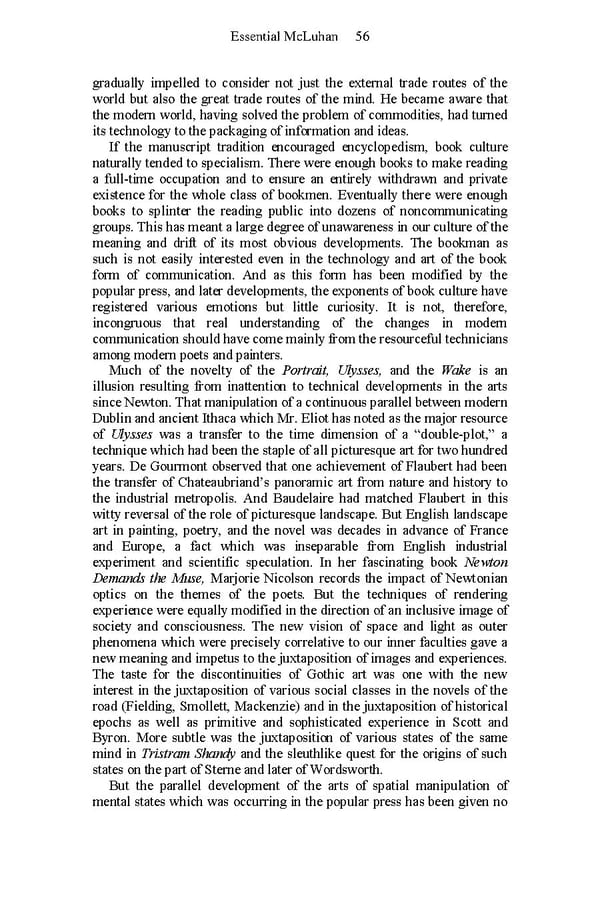Essential McLuhan 56 gradually impelled to consider not just the external trade routes of the world but also the great trade routes of the mind. He became aware that the modern world, having solved the problem of commodities, had turned its technology to the packaging of information and ideas. If the manuscript tradition encouraged encyclopedism, book culture naturally tended to specialism. There were enough books to make reading a full-time occupation and to ensure an entirely withdrawn and private existence for the whole class of bookmen. Eventually there were enough books to splinter the reading public into dozens of noncommunicating groups. This has meant a large degree of unawareness in our culture of the meaning and drift of its most obvious developments. The bookman as such is not easily interested even in the technology and art of the book form of communication. And as this form has been modified by the popular press, and later developments, the exponents of book culture have registered various emotions but little curiosity. It is not, therefore, incongruous that real understanding of the changes in modern communication should have come mainly from the resourceful technicians among modern poets and painters. Much of the novelty of the Portrait, Ulysses, and the Wake is an illusion resulting from inattention to technical developments in the arts since Newton. That manipulation of a continuous parallel between modern Dublin and ancient Ithaca which Mr. Eliot has noted as the major resource of Ulysses was a transfer to the time dimension of a “double-plot,” a technique which had been the staple of all picturesque art for two hundred years. De Gourmont observed that one achievement of Flaubert had been the transfer of Chateaubriand’s panoramic art from nature and history to the industrial metropolis. And Baudelaire had matched Flaubert in this witty reversal of the role of picturesque landscape. But English landscape art in painting, poetry, and the novel was decades in advance of France and Europe, a fact which was inseparable from English industrial experiment and scientific speculation. In her fascinating book Newton Demands the Muse, Marjorie Nicolson records the impact of Newtonian optics on the themes of the poets. But the techniques of rendering experience were equally modified in the direction of an inclusive image of society and consciousness. The new vision of space and light as outer phenomena which were precisely correlative to our inner faculties gave a new meaning and impetus to the juxtaposition of images and experiences. The taste for the discontinuities of Gothic art was one with the new interest in the juxtaposition of various social classes in the novels of the road (Fielding, Smollett, Mackenzie) and in the juxtaposition of historical epochs as well as primitive and sophisticated experience in Scott and Byron. More subtle was the juxtaposition of various states of the same mind in Tristram Shandy and the sleuthlike quest for the origins of such states on the part of Sterne and later of Wordsworth. But the parallel development of the arts of spatial manipulation of mental states which was occurring in the popular press has been given no
 Essential McLuhan Page 62 Page 64
Essential McLuhan Page 62 Page 64